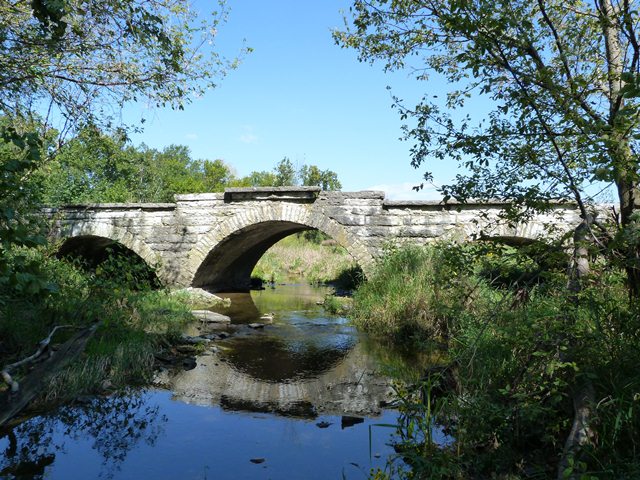We Recommend:
Bach Steel - Experts at historic truss bridge restoration.
BridgeHunter.com Phase 1 is released to the public! - Visit Now
CR-250 South Bridge
Decatur County Bridge 118

Primary Photographer(s): Nathan Holth and Rick McOmber
Bridge Documented: September 22, 2012
Rural: Decatur County, Indiana: United States
By Builder/Contractor: Unknown
Not Available or Not Applicable
20.3 Feet (6.2 Meters)
63.0 Feet (19.2 Meters)
16.4 Feet (5 Meters)
3 Main Span(s)
1600096

View Information About HSR Ratings
Bridge Documentation
View Archived National Bridge Inventory Report - Has Additional Details and Evaluation
This bridge is largely unaltered, something that cannot be said for all of the many stone arch bridges in this area. Its multi-span configuration, along with a center span that is a foot longer with a two foot higher rise, gives the bridge an attractive, appearance that is varied yet symmetrical. Historic bridge survey research found information that indicated that one of three bridges over Sand Creek dates to 1872. If it turned out to be this one, this bridge would be among the older of the stone arch bridges in this area, since a fair number date to as late as the early 20th Century. The generic 1890 date in the National Bridge Inventory is used for a bunch of the stone arch bridges in this area and is almost certainly incorrect.
Information and Findings From DHPA Historic Bridge SurveyStatement of Significance Although all three arches are segmental, the central one comes close to being a semicircular one. The bridge's design, therefore, moved cautiously away from the standard. Very few of Decatur County's segmental arches are multispan. Architectural Description Local craftsmen built most of Indiana's stone arches from regional materials just before or in the first fifteen years of the twentieth century. Most stonemasons preferred full-centered or semicircular arches in
which the line of pressure passes through the center of each stone in the arch ring until carried vertically into the substructure. In some cases, though, masons erected segmental arches in which the intrados is less than half a
circle. To function successfully, segmental arches require the substructure to accommodate some horizontal as well as some vertical pressure. Other Information In March 1872, the Decatur board appropriated $500 as a contribution to the Sand Creek Turnpike Company to aid in "constructing a bridge across Sand Creek on their road." The appropriation could have applied to #114, #118, or #190. Bridge Considered Historic By Survey: Yes |
![]()
Photo Galleries and Videos: CR-250 South Bridge
Bridge Photo-Documentation
Original / Full Size PhotosA collection of overview and detail photos. This gallery offers photos in the highest available resolution and file size in a touch-friendly popup viewer.
Alternatively, Browse Without Using Viewer
![]()
Bridge Photo-Documentation
Mobile Optimized PhotosA collection of overview and detail photos. This gallery features data-friendly, fast-loading photos in a touch-friendly popup viewer.
Alternatively, Browse Without Using Viewer
![]()
Maps and Links: CR-250 South Bridge
Coordinates (Latitude, Longitude):
Search For Additional Bridge Listings:
Bridgehunter.com: View listed bridges within 0.5 miles (0.8 kilometers) of this bridge.
Bridgehunter.com: View listed bridges within 10 miles (16 kilometers) of this bridge.
Additional Maps:
Google Streetview (If Available)
GeoHack (Additional Links and Coordinates)
Apple Maps (Via DuckDuckGo Search)
Apple Maps (Apple devices only)
Android: Open Location In Your Map or GPS App
Flickr Gallery (Find Nearby Photos)
Wikimedia Commons (Find Nearby Photos)
Directions Via Sygic For Android
Directions Via Sygic For iOS and Android Dolphin Browser
USGS National Map (United States Only)
Historical USGS Topo Maps (United States Only)
Historic Aerials (United States Only)
CalTopo Maps (United States Only)

